Originally released back in 1979, Guess Who? quickly became one of the most popular board games for children and families. It was one of my favorite board games when I was young. While I kind of grew out of the game, I still have fond memories of it. For such a simple game you wouldn’t think that there is much strategy. If you ask the right questions though, you can greatly increase your odds of winning the game.
Guess Who? is a simplified deduction game meant for people of all ages. Basically each player chooses a secret identity, and the objective of the game is to guess your opponent’s identity. You will do this by asking yes or no questions. With each question you will eliminate some of the potential secret identities of your opponent. Check out our how to play guide for the full rules of Guess Who?
While the game meant for children, that doesn’t mean that there isn’t strategy. In fact you can devise a strategy that will greatly improve your chances of winning the game. That is my objective in this post. If you follow these steps, you can solve the identity of your opponent’s character within four or five questions every single game. You then just need to ask one final question to confirm the other player’s identity.
In this post I will begin with talking about the premise of my strategy by looking at how the game was designed. This includes a methodology you can follow to create your own strategy. If you are just interested in a series of questions that you can ask to improve your odds of winning the game, check out the Guess Who? questions section below.
The Basic Way of Asking Questions in Guess Who?
When most people especially children first start playing the game they will start asking very straightforward questions. These questions could include things such as:
- Does your person have brown hair?
- Does your character wear glasses?
- Do they have a beard?
It makes a lot of sense that most players start with straightforward questions like these. The rules specifically call out questions like these as ones you can ask in the game. Younger children are likely to go with more obvious questions rather than more unique out of the box type questions.
These questions are perfectly fine to ask in the game. In some cases they can be very helpful if you find one of the unique characteristics of your opponent’s character. Most of the time these questions will only eliminate a couple options though.
This is far from optimal. If your opponent approaches their questions in a different way, you can fall behind really quickly. To improve your odds of winning the game, you need to move onto advanced questions.
The Rule of Five
Before I get into what you should emphasize when you choose a question to ask, I want to discuss some game design that went into Guess Who?.
If you look closely at the characters, you quickly start to realize that the characteristics are not random. They were actually chosen for a very specific reason.
Lets take a look at some of the characteristics in the original version of the game:
- Bald – Five characters are bald/balding.
- Beards – Four characters have a beard.
- Mustaches – Five characters have a mustache.
- Big Lips – Five characters have big/thick lips.
- Big Nose – Six of the characters have a big nose.
- Blue Eyes – Five characters have blue eyes.
- Bushy Eyebrows – Five characters have bushy eyebrows.
- Female – Five characters are women/girls.
- Glasses – Five characters wear glasses.
- Hair Color – All hair colors except for brown have five characters that share the same color.
- Hats – Five characters wear hats.
After reading through that list, a number keeps popping up. For many of the major characteristics, exactly five (sometimes four or six) characters have that characteristic. This might seem like a coincidence, but it was purposefully designed into the game. In more recent versions of the game this isn’t as prevalent, but it still plays a role.
This was done so most of the time an obvious question would only eliminate a small portion of the remaining characters. For example lets say you ask if the character has glasses. Since only five of the characters are wearing glasses, more times than not that question will only eliminate five or less characters. Occasionally you can eliminate up to 19 characters, but that is against the odds.
This is why asking basic/obvious questions is usually not a great strategy. This is the reason why you need to start asking more complex questions.
Ask More Complex Questions
Asking simple questions usually only eliminate 20% or less of the characters. The ultimate goal is to increase that to close to 50% for each question. This is where more unique or complex questions come into play.
The rules for every version of Guess Who? don’t give many restrictions on what questions you can ask the other players. It just needs to be a yes or no question. Most people naturally follow the simple questions that the game suggests you ask. While it might be against the spirit of the game, there is nothing in the rules to stop you from asking more complex questions.
Ultimately before you ask a question you want to try and form one that will eliminate close to 50% of the options no matter what response you receive. In most cases this will significantly decrease the number of questions that you have to ask in the game. For example using a simple question you likely will only eliminate five suspects and leave 19 remaining. Instead you want to find a question that will eliminate twelve of the 24 suspects.
What question you end up asking is going to depend heavily on what version of the game you are playing. The roster of people have changed a number of times and the same question won’t work as well in each version. See below for a set of sample questions that you can use in each version of the game.
For example here is a question you can ask in the original versions of the game: Is your character wearing a man-made object (hat, glasses, jewelry, bows)? By forming the question like this you are creating two groups of people. Those that have a man-made object include eleven characters and those without one total thirteen. No matter what answer you receive, you will be able to eliminate at least eleven characters. This likely would have taken two or more questions to achieve if you used basic questions.
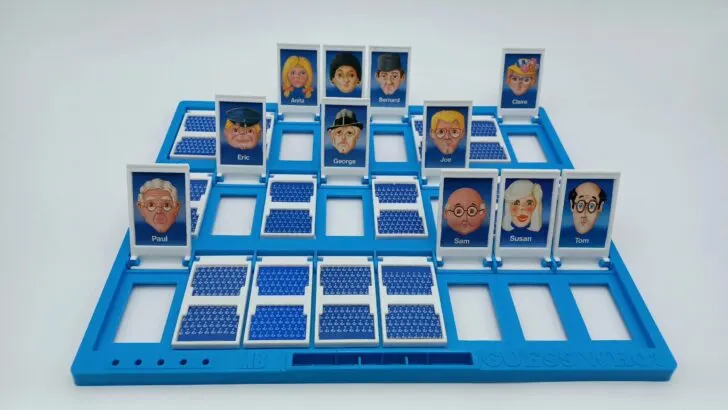
For your next question you would then think of another question that cuts the number of options in half again.
Other questions you could ask include asking about multiple different colors of hair at the same time, or asking about facial hair instead of just a beard or mustache. Another good option is to use ranges of first letters from the characters’ names. For example you could ask: Does your character’s name start with letters A through J?
By eliminating around half of the options with each question, you are guaranteed to figure out your opponent’s identity within four or five questions. Then with the last question asking about the character’s name, you will solve the identity within five or six questions.
Falling Behind, Change Up Your Strategy
If you go first or are playing against someone who doesn’t really understand the advanced strategy, you very likely will win using the above strategy. The one exception is if the other player asks a simple question and gets lucky in picking one of the unique characteristics of your mystery person. If your opponent goes first and asks good questions, you may have to adjust your strategy as well.
If you ever fall behind the other player (they have eliminated more people than you have), you have to start following a more risky strategy. In this case you actually are best off going back to more basic questions. If the other player is using a strategy to eliminate half of the suspects each question, you will never catch up if you also try to eliminate half each turn. Instead you need to start asking questions that can eliminate a lot of options at a time.
Simple questions actually do a good job at helping you catch up if you pick the right question to ask. The downside is you have a good chance of falling even further behind. If you get one good result though, you can actually get ahead very quickly. Once you are ahead you should go back to trying to eliminate half of the options with each question.
Questions to ask in Guess Who?
The characters have changed a number of times throughout the history of the game. Check out my post on the history of Guess Who? for a more detailed look at how the game has changed. Since the characters have changed, the set of questions you should ask depends on which version of the game you are playing. Check out the corresponding section below for the version of the game that you own.
The key to each version of the game is the first two or three questions that you ask. To increase your odds of winning the game, these first questions needs to eliminate close to half of the options no matter what answer you receive. For each version I would recommend following the first two or three questions I have come up with since they eliminate half or close to half of the options. After the first two or three questions, the individual questions are not as important. At this point you just need to come up with a question that eliminates close to half of the people each time. I provided sample questions you could ask, but there are quite a few other ones that work just as well as the questions I have included.
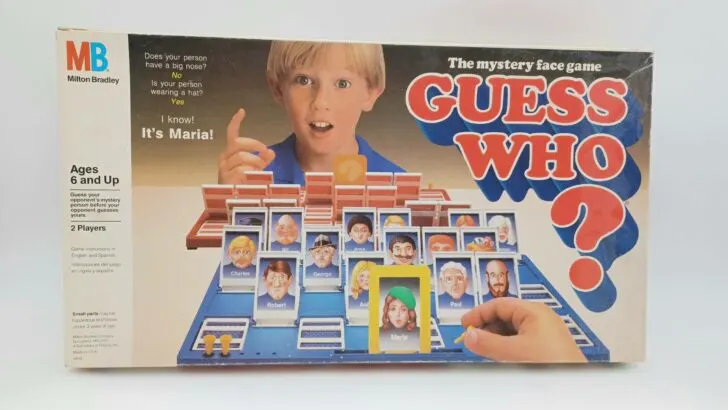
1979-1995
The original version of Guess Who? didn’t really change all that much until 1996. Therefore the same set of questions should work for any version of the game from 1979 to 1995 (this excludes the Lakeside version of the game).
While it may seem like an odd question, the first question you should ask in the original version is as follows: Does your person have a man-made item on their face/head (Hat, Glasses, Jewelry, Bow)? This question is not a typical question most people would ask, but it works well since eleven characters have a man-made object while thirteen do not. Since the goal is to eliminate around half of the options each question, this gets quite close to that number.
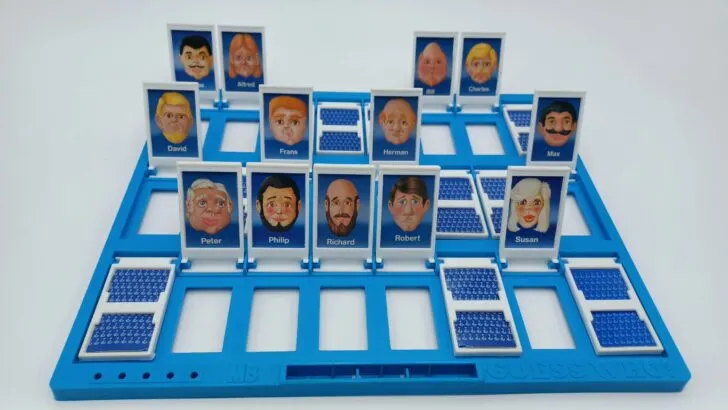
The next set of questions you should ask depend on what responses you receive.
- Yes: Has man-made object: (Anita, Anne, Bernard, Claire, Eric, George, Joe, Maria, Paul, Sam, Tom). Is the person wearing glasses?
- No: Not wearing glasses (Anita, Anne, Bernard, Eric, George, Maria). Is your person female?
- Yes: Female (Anita, Anne, Maria). Is your person a child?
- Yes – Anita (5 Questions)
- No: Adult (Anne, Maria). Is your person white? (You may have to alter this question in some versions since Anne is white in some versions of the game.)
- Yes – Maria (6 Questions)
- No – Anne (6 Questions)
- No: Male (Bernard, Eric, George). Does your person have white hair?
- Yes – George (5 Questions)
- No: Not white hair (Bernard, Eric). Does your person have brown hair?
- Yes – Bernard (6 Questions)
- No – Eric (6 Questions)
- Yes: Female (Anita, Anne, Maria). Is your person a child?
- Yes: Wearing Glasses (Claire, Joe, Paul, Sam, Tom). Is your person balding?
- Yes: Balding (Sam, Tom). Does your person have white hair?
- Yes – Sam (5 Questions)
- No – Tom (5 Questions)
- No: Not balding (Claire, Joe, Paul). Does your person have white hair?
- Yes – Paul (5 Questions)
- No: Not white hair (Claire, Joe). Does your person have yellow hair?
- Yes – Joe (6 Questions)
- No – Claire (6 Questions)
- Yes: Balding (Sam, Tom). Does your person have white hair?
- No: Not wearing glasses (Anita, Anne, Bernard, Eric, George, Maria). Is your person female?
- No: Does not have man-made object (Alex, Alfred, Bill, Charles, David, Frans, Herman, Max, Peter, Philip, Richard, Robert, Susan). Does your person have facial hair (beard/mustache)?
- Yes: Facial hair (Alex, Alfred, Bill, Charles, David, Max, Philip, Richard). Does your person have a beard?
- Yes: Beard (Bill, David, Philip, Richard). Does your person have darker hair (brown or black)?
- Yes: Darker hair (Philip, Richard). Is your person balding?
- Yes – Richard (6 Questions)
- No – Philip (6 Questions)
- No: Lighter Hair (Bill, David). Is your person balding?
- Yes – Bill (6 Questions)
- No – David (6 Questions)
- Yes: Darker hair (Philip, Richard). Is your person balding?
- No: No beard (Alex, Alfred, Charles, Max). Does your person have black hair?
- Yes: Black hair (Alex, Max). Does your person have a thick mustache?
- Yes – Max (6 Questions)
- No – Alex (6 Questions)
- No: Not black hair (Alfred, Charles). Does your person have yellow hair?
- Yes – Charles (6 Questions)
- No – Alfred (6 Questions)
- Yes: Black hair (Alex, Max). Does your person have a thick mustache?
- Yes: Beard (Bill, David, Philip, Richard). Does your person have darker hair (brown or black)?
- No: No facial hair (Frans, Herman, Peter, Robert, Susan). Does your person have white hair?
- Yes: White hair (Peter, Susan). Is your person male?
- Yes – Peter (5 Questions)
- No – Susan (5 Questions)
- No: Not white hair (Frans, Herman, Robert). Does your person have blue eyes?
- Yes – Robert (5 Questions)
- No: Not blue eyes (Frans, Herman). Is your person balding?
- Yes – Herman (6 Questions)
- No – Frans (6 Questions)
- Yes: White hair (Peter, Susan). Is your person male?
- Yes: Facial hair (Alex, Alfred, Bill, Charles, David, Max, Philip, Richard). Does your person have a beard?
1996-2002
Up until 1996 Guess Who? didn’t really change much from the original game. 1996 was the first year that the character designs actually changed. Most of the characters look the same, but were drawn in a different style. There were a couple changes to a few characters though, which mean the questions from the original version of the game don’t work exactly the same. The first question you should ask is exactly the same, and many of the other early questions are similar.
The first question you should ask on your turn is: Is your person wearing a man-made object on their head?
- Yes: Has man-made object. (Anne, Bernard, Claire, Eric, George, Joe, Maria, Paul, Sam, Susan, Tom) Is you character wearing glasses?
- Yes: Wearing glasses (Claire, Joe, Paul, Sam, Tom) Is your person balding?
- Yes: Balding (Sam, Tom) Does your person have white hair?
- Yes – Sam (5 questions)
- No – Tom (5 questions)
- No: Not balding (Claire, Joe, Paul) Is your character a woman?
- Yes – Claire (5 questions)
- No: Man – (Joe, Paul) Does your person have white hair?
- Yes – Paul (6 questions)
- No – Joe (6 questions)
- Yes: Balding (Sam, Tom) Does your person have white hair?
- No: Not wearing glasses (Anne, Bernard, Eric, George, Maria, Susan) Is you character a man/woman? (You can choose either question.)
- Man (Bernard, Eric, George) Does your character have brown hair?
- Yes – Bernard (5 questions)
- No: Not Brown Hair (Eric, George) Does your character have blonde hair?
- Yes – Eric (6 questions)
- No – George (6 questions)
- Woman (Anne, Maria, Susan) Is your person wearing a hat?
- Yes – Maria (5 questions)
- No: Not wearing a hat (Anne, Susan) Does your person have blonde hair?
- Yes – Susan (6 questions)
- No – Anne (6 questions)
- Man (Bernard, Eric, George) Does your character have brown hair?
- Yes: Wearing glasses (Claire, Joe, Paul, Sam, Tom) Is your person balding?
- No. Does not have man-made object. (Alex, Alfred, Anita, Bill, Charles, David, Frans, Herman, Max, Peter, Philip, Richard, Robert) Does your character have facial hair (beard/mustache)?
- Yes: Has facial hair. (Alex, Alfred, Bill, Charles, David, Max, Philip, Richard) Does your character have a beard?
- Yes: Beard (Bill, David, Philip, Richard) Is you character bald?
- Yes: Bald (Bill, Richard) Does your character have red/orange hair?
- Yes – Bill (6 questions)
- No – Richard (6 questions)
- No: Not bald (David, Philip) Does your character have black hair?
- Yes – Philip (6 questions)
- No – David (6 questions)
- Yes: Bald (Bill, Richard) Does your character have red/orange hair?
- No: No beard (Alex, Alfred, Charles, Max) Does your character have black hair?
- Yes: Black hair (Alex, Max) Does your person have a large nose?
- Yes – Max (6 questions)
- No – Alex (6 questions)
- No: Not black hair (Alfred, Charles) Is your character smiling?
- Yes – Charles (6 questions)
- No – Alfred (6 questions)
- Yes: Black hair (Alex, Max) Does your person have a large nose?
- Yes: Beard (Bill, David, Philip, Richard) Is you character bald?
- No: Does not have facial hair. (Anita, Frans, Herman, Peter, Robert) Does your character have red/orange hair?
- Yes: Red/Orange hair (Frans, Herman) Is your character balding?
- Yes – Herman (5 questions)
- No – Frans (5 questions)
- No: Not red/orange hair (Anita, Peter, Robert) Does your character have white hair?
- Yes: White hair (Anita, Peter) Is your character a woman?
- Yes – Anita (6 questions)
- No – Peter (6 questions)
- No – Robert (5 questions)
- Yes: White hair (Anita, Peter) Is your character a woman?
- Yes: Red/Orange hair (Frans, Herman) Is your character balding?
- Yes: Has facial hair. (Alex, Alfred, Bill, Charles, David, Max, Philip, Richard) Does your character have a beard?
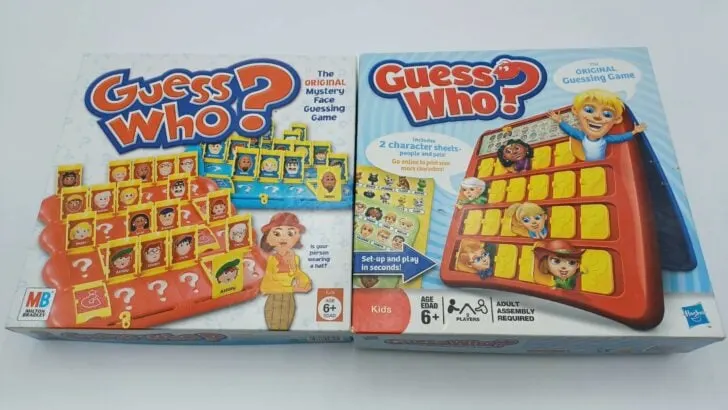
2003-2016
The 2003 version of Guess Who? was the first that actually significantly differed from the original version of the game. Most of the character names were changed, and the characteristics do not match those from the earlier versions of the game. Because of this a lot of the questions you should ask in the game differ from the earlier versions.
The first question you should ask doesn’t change though. You should start the game by asking: Does your person have a man-made object on their head (earrings, glasses, hat)?
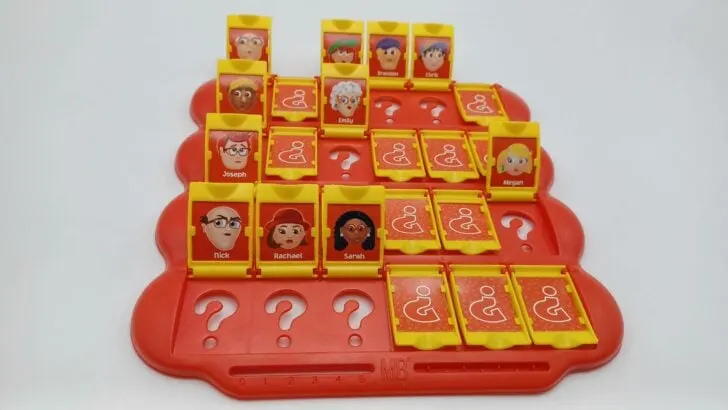
- Yes: Has man-made object. (Alex, Ashley, Brandon, Chris, Daniel, Emily, Joseph, Megan, Nick, Rachael, Sarah) Is your character a woman?
- Yes: Woman (Ashley, Emily, Megan, Rachael, Sarah) Is your person wearing glasses?
- Yes: Has glasses. (Emily, Sarah) Does your character have black hair?
- Yes – Sarah (5 questions)
- No – Emily (5 questions)
- No: Doesn’t have glasses. (Ashley, Megan, Rachael) Is your person wearing a hat?
- Yes: Wearing a hat. ( Ashley, Rachael) Does you character have red hair?
- Yes – Ashley (6 questions)
- No – Rachael (6 questions)
- No: Not wearing a hat. – Megan (5 questions)
- Yes: Wearing a hat. ( Ashley, Rachael) Does you character have red hair?
- Yes: Has glasses. (Emily, Sarah) Does your character have black hair?
- No: Man (Alex, Brandon, Chris, Daniel, Joseph, Nick) Is your person wearing a hat?
- Yes: Wearing a hat. (Brandon, Chris, Daniel) Is the hat yellow?
- Yes: Yellow hat. – Daniel (5 questions)
- No: The hat is not yellow. (Brandon, Chris) Does your character have blond hair?
- Yes – Brandon (6 questions)
- No – Chris (6 questions)
- No: Not wearing a hat. (Alex, Joseph, Nick) Is your character balding?
- Yes: Balding (Alex, Nick) Does your character have blue eyes?
- Yes – Nick (6 questions)
- No – Alex (6 questions)
- No: Not bald. – Joseph (5 questions)
- Yes: Balding (Alex, Nick) Does your character have blue eyes?
- Yes: Wearing a hat. (Brandon, Chris, Daniel) Is the hat yellow?
- Yes: Woman (Ashley, Emily, Megan, Rachael, Sarah) Is your person wearing glasses?
- No: Does not have man-made object. (Andy, Connor, David, Jake, James, Jon, Joshua, Justin, Kyle, Matt, Tyler, William, Zachary) Does your character have a mustache?
- Yes: Has mustache. (Connor, Jake, Joshua, Justin, Tyler) Does your character have brown hair?
- Yes: Brown hair. (Connor, Justin) Is your character black?
- Yes – Connor (5 questions)
- No – Justin (5 questions)
- No: Not brown hair. (Jake, Joshua, Tyler) Does your character have a big nose?
- Yes: Big nose. (Joshua, Tyler) Does your character have white hair?
- Yes – Joshua (6 questions)
- No – Tyler (6 questions)
- No: Nose is not big – Jake (5 questions)
- Yes: Big nose. (Joshua, Tyler) Does your character have white hair?
- Yes: Brown hair. (Connor, Justin) Is your character black?
- No: Does not have mustache. (Andy, David, James, Jon, Kyle, Matt, William, Zachary) Is your character looking upwards?
- Yes: Looking upwards. (David, James, Jon, Zachary) Does your character have any red hair?
- Yes: Red hair. (David, Zachary) Does your character have a beard?
- Yes – David (6 questions)
- No – Zachary (6 questions)
- No: Not red hair. (James, Jon) Is your character balding?
- Yes – James (6 questions)
- No – Jon (6 questions)
- Yes: Red hair. (David, Zachary) Does your character have a beard?
- No: Not looking upwards. (Andy, Kyle, Matt, William) Is your character blonde?
- Yes: Blonde (Kyle, William) Does your character have blue eyes?
- Yes – Kyle (6 questions)
- No – William (6 questions)
- No: Not blonde (Andy, Matt) Does your character have white hair?
- Yes – Matt (6 questions)
- No – Andy (6 questions)
- Yes: Blonde (Kyle, William) Does your character have blue eyes?
- Yes: Looking upwards. (David, James, Jon, Zachary) Does your character have any red hair?
- Yes: Has mustache. (Connor, Jake, Joshua, Justin, Tyler) Does your character have brown hair?
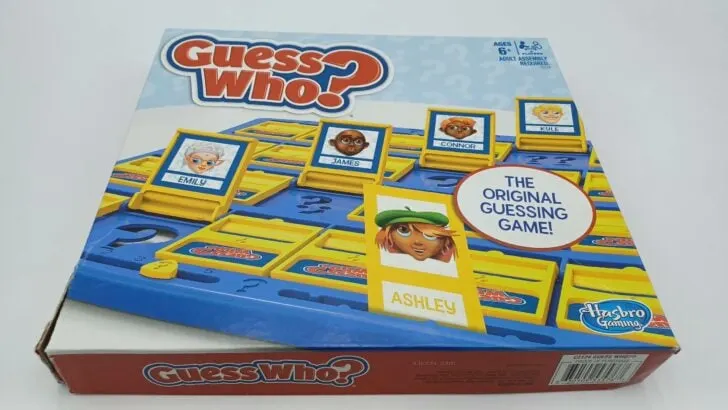
2017
With 2017 being the first version of Guess Who? that includes an equal number of men and women, obviously the best first question to ask in the game would be about whether the character is a man/woman. For this set of questions I am not going to start with that though. First, later versions of the game recommend that you don’t start with the question. Second it feels kind of too simple just asking about gender to get rid of half of the characters.
Instead I am going to start with a much more interesting question. I would ask a question such as “Does your character have something on/in their hair?” This would include hats, headbands, and hair ties. This might seem like an odd question, but it actually does a pretty good job eliminating around half of the options no matter what answer is given.
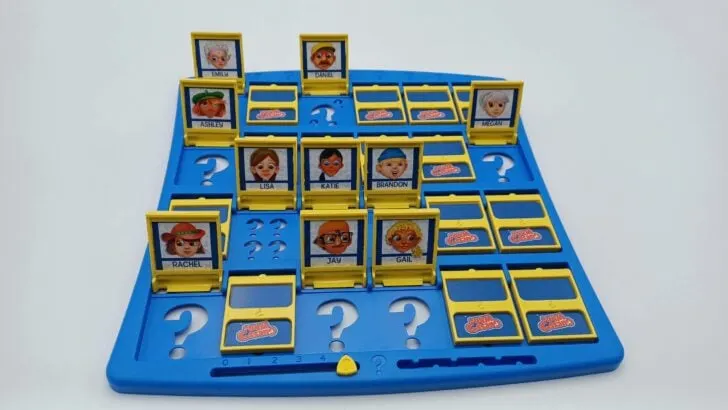
- Has something on/in their hair. (Ashley, Brandon, Daniel, Emily (headband), Gail (hair tie), Jay, Katie (hair tie), Lisa (headband), Megan (hair tie), Rachel). Is your character wearing a hat?
- Yes: Wearing a hat. (Ashley, Brandon, Daniel, Jay, Rachel). Is your character a woman?
- Yes: Woman (Ashley, Rachel). Is your character wearing earrings?
- Yes – Ashley (5 questions)
- No – Rachel (5 questions)
- No: Man (Brandon, Daniel, Jay). Does your character have a mustache?
- Yes – Daniel (5 questions)
- No: No mustache (Brandon, Jay). Is your character wearing glasses?
- Yes – Jay (6 questions)
- No – Brandon (6 questions)
- Yes: Woman (Ashley, Rachel). Is your character wearing earrings?
- No: Not wearing a hat. (Emily, Gail, Katie, Lisa, Megan). Does your character have white hair?
- Yes: White hair. (Emily, Megan). Is your character wearing glasses?
- Yes – Emily (5 questions)
- No – Megan (5 questions)
- No: Not white hair (Gail, Katie, Lisa). Is your character’s eyes blue?
- Yes – Katie (5 questions)
- No (Gail, Lisa). Does your character wear earrings?
- Yes – Lisa (6 questions)
- No – Gail (6 questions)
- Yes: White hair. (Emily, Megan). Is your character wearing glasses?
- Yes: Wearing a hat. (Ashley, Brandon, Daniel, Jay, Rachel). Is your character a woman?
- Does not have anything on/in their hair. (Andy, Connor, David, Donna, Jake, James, Jess, Jon, Joseph, Kyle, Liz, Nick, Rebecca, Sarah). Does the person have less than five letters in their name?
- Yes: Less than five letters in name. (Andy, Jake, Jess, Jon, Kyle, Lix, Nick). Does the character have white hair?
- Yes: White hair (Jake, Jon, Nick). Is the person wearing glasses?
- No – Nick (5 questions)
- Yes: Glasses – (Jake, Jon). Does the person have a mustache?
- Yes – Jake (6 questions)
- No – Jon (6 questions)
- No: Not white hair (Andy, Jess, Kyle, Liz). Is your character a woman?
- Yes: Woman (Jess, Liz). Does your character have blond hair?
- Yes – Jess (6 questions)
- No – Liz (6 questions)
- No: Man (Andy, Kyle). Does your character have a beard?
- Yes – Andy (6 questions)
- No – Kyle (6 questions)
- Yes: Woman (Jess, Liz). Does your character have blond hair?
- Yes: White hair (Jake, Jon, Nick). Is the person wearing glasses?
- No: Five or more letters in name (Connor, David, Donna, James, Joseph, Rebecca, Sarah). Is your character a man?
- Yes: Man (Connor, David, James, Joseph). Is your character bald/balding?
- Yes: Balding (David, James). Does your character have an earring?
- Yes – James (6 questions)
- No – David (6 questions)
- No: Not balding (Connor, Joseph). Is your character wearing glasses?
- Yes – Joseph (6 questions)
- No – Connor (6 questions)
- Yes: Balding (David, James). Does your character have an earring?
- No: Woman (Donna, Rebecca, Sarah). Does your character wear glasses?
- Yes: Glasses (Donna, Sarah). Does your character have black hair?
- Yes – Sarah (6 questions)
- No – Donna (6 questions)
- No: No Glasses – Rebecca (5 questions)
- Yes: Glasses (Donna, Sarah). Does your character have black hair?
- Yes: Man (Connor, David, James, Joseph). Is your character bald/balding?
- Yes: Less than five letters in name. (Andy, Jake, Jess, Jon, Kyle, Lix, Nick). Does the character have white hair?
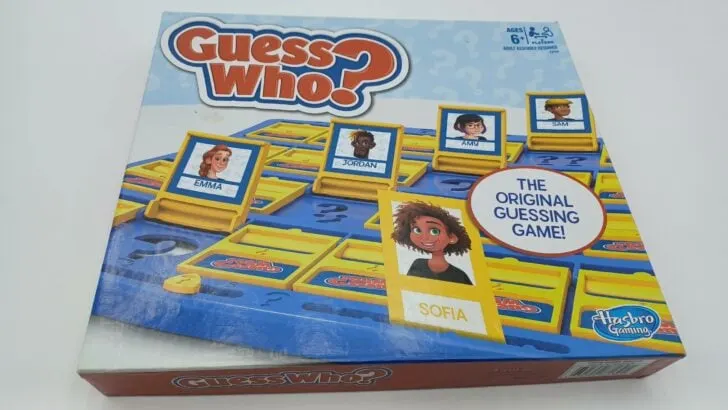
2018-Present
Which question you should ask first in the newest versions of Guess Who? depends on whether you are playing where you can ask about gender in your first question. While it is not prohibited, it is encouraged to wait to ask until your third question in order to make the game more challenging. The reason this matters is if the players are allowing this question right away, you should always ask it first as it automatically eliminates half of the people. For this set of questions I will follow the more advanced rules and not ask it until later. I would suggest following this line of questions in order to minimize the number of questions that you have to ask.
For your first question you should ask if the person has brown eyes. This is a good first question because thirteen of the 24 characters have brown eyes. This will automatically eliminate close to half of the options no matter what answer you receive.
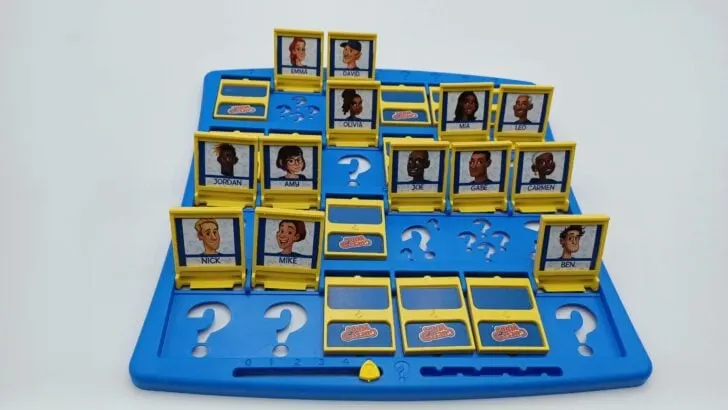
- Yes: Brown eyes (Amy, Ben, Carmen, David, Emma, Gabe, Joe, Jordan, Leo, Mia, Mike, Nick, Olivia) Is the person is looking to the left?
- Yes: Looking to the left. (David, Gabe, Joe, Jordan, Leo, Mike) Does the person have facial hair (beard/mustache)?
- Yes: Facial hair. (David, Joe, Jordan, Leo) Do they have any white hair?
- Yes: White hair. (Joe, Leo) Is the person bald?
- Yes – Joe (6 questions)
- No – Leo (6 questions)
- No: Not white hair. (David, Jordan) Is the person wearing a hat?
- Yes – David (6 questions)
- No – Jordan (6 questions)
- Yes: White hair. (Joe, Leo) Is the person bald?
- No: No facial hair. (Gabe, Mike) Is the person wearing a hat?
- Yes – Mike (5 questions)
- No – Gabe (5 questions)
- Yes: Facial hair. (David, Joe, Jordan, Leo) Do they have any white hair?
- No: Not looking to the left. (Amy, Ben, Carmen, Emma, Mia, Nick, Olivia) Is any of the person’s hair black?
- Yes: Has black hair. (Amy, Mia, Olivia) Did the person dye part of their hair?
- Yes: Part of hair is dyed. (Amy, Olivia) Is your person wearing glasses?
- Yes – Amy (6 questions)
- No – Olivia (6 questions)
- No: No hair dye – Mia (5 questions)
- Yes: Part of hair is dyed. (Amy, Olivia) Is your person wearing glasses?
- No: No black hair. (Ben, Carmen, Emma, Nick) Is your character a woman?
- Yes: Woman (Carmen, Emma) Does your person have long hair?
- Yes – Emma (6 questions)
- No – Carmen (6 questions)
- No: Man (Ben, Nick) Is your character wearing glasses?
- Yes – Ben (6 questions)
- No – Nick (6 questions)
- Yes: Woman (Carmen, Emma) Does your person have long hair?
- Yes: Has black hair. (Amy, Mia, Olivia) Did the person dye part of their hair?
- Yes: Looking to the left. (David, Gabe, Joe, Jordan, Leo, Mike) Does the person have facial hair (beard/mustache)?
- No: Not brown eyes. (Al, Daniel, Eric, Farrah, Katie, Laura, Lily, Liz, Rachel, Sam, Sofia) Does your character have green eyes?
- Yes: Green eyes. (Al, Daniel, Laura, Lily, Sam, Sofia) Is you character a man/woman? (It doesn’t matter which way you ask the question).
- Man (Al, Daniel, Sam) Does the character have facial hair?
- Yes: Facial hair. (Al, Daniel) Are they wearing glasses?
- Yes – Al (6 questions)
- No – Daniel (6 questions)
- No: No facial hair – Sam (5 questions)
- Yes: Facial hair. (Al, Daniel) Are they wearing glasses?
- Woman (Laura, Lily, Sofia) Is you character wearing anything on their head?
- Yes: Has something on head. – Lily (5 questions)
- No: Has nothing on head. (Laura, Sofia) Does your character have black hair?
- Yes – Laura (6 questions)
- No – Sofia (6 questions)
- Man (Al, Daniel, Sam) Does the character have facial hair?
- No: Not green eyes. (Eric, Farah, Katie, Liz, Rachel) Is your character wearing glasses?
- Yes: Glasses (Lix, Rachel) Does your character have brown hair?
- Yes – Rachel (5 questions)
- No – Liz (5 questions)
- No: No glasses (Eric, Farah, Katie) Is your character a man?
- Man – Eric (5 questions)
- Woman (Farah, Katie) Does your person have a hat?
- Yes – Katie (6 questions)
- No – Farah (6 questions)
- Yes: Glasses (Lix, Rachel) Does your character have brown hair?
- Yes: Green eyes. (Al, Daniel, Laura, Lily, Sam, Sofia) Is you character a man/woman? (It doesn’t matter which way you ask the question).
Questions?
Do you have any questions about the strategy I outlined above, or need more clarification? Leave a comment and I will try to reply as quickly as possible.

History of Guess Who?: Timeline of the Changes to the Classic Board Game - Geeky Hobbies
Saturday 10th of February 2024
[…] in the game as I found other games that I enjoyed more. This is partially due to there being a Guess Who? strategy that you should follow in order to maximize your chances of winning the game. I don’t enjoy […]
Guess Who? Board Game: Rules and Instructions for How to Play - Geeky Hobbies
Friday 21st of July 2023
[…] If you would like to see how to improve your chances of winning, check out our post about Guess Who? strategy. […]
Sophie
Tuesday 17th of November 2020
When I used to play this game, I'd ask questions like the ones on the box. Now I am going to try and ask about the man-made items, and if they have a big nose. Is it worth it to ask if they are male or female?
Eric Mortensen
Wednesday 18th of November 2020
Statistically it usually isn't great to ask male or female early in the game as there are significantly more male characters than female characters in the game (at least in the older versions of the game). If the other player's character is a male it won't help you a lot because it won't eliminate many characters. If their character is a female though it will help a lot as you will immediately eliminate a large majority of the characters. Early in the game asking male or female is a very high risk reward question. In most cases it won't help much, but in certain situations it will help a lot.
Statistically you are best off trying to ask a question that will eliminate close to half of the characters no matter if you receive a yes or a no. If you consistently do this you can win within around six questions no matter what you ask. If you choose to ask questions that have more characters that correspond to one of the answers you have the possibility to get rid of a lot of characters quickly, but you have a better chance of only being able to get rid of a few characters.
Rilian
Wednesday 11th of May 2016
letters and combined questions are not in the spirit of the game.
Eric Mortensen
Wednesday 11th of May 2016
I agree that using letters and combined questions are not in the spirit of Guess Who. If you are really competitive and don't care about following the spirit of the game though they make it much easier to win the game.